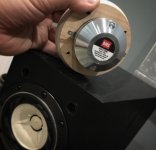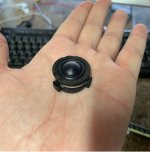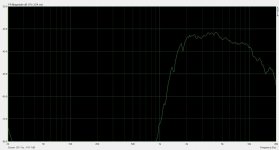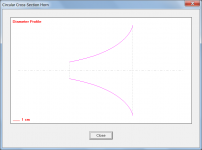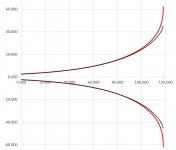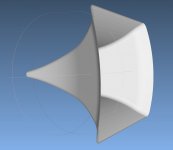and don't forget the falling response of mid and larger compression drivers (non ring radiators), usually rolling off 6db an octave past 3khz.
Here's four "real world" examples to illustrate this:
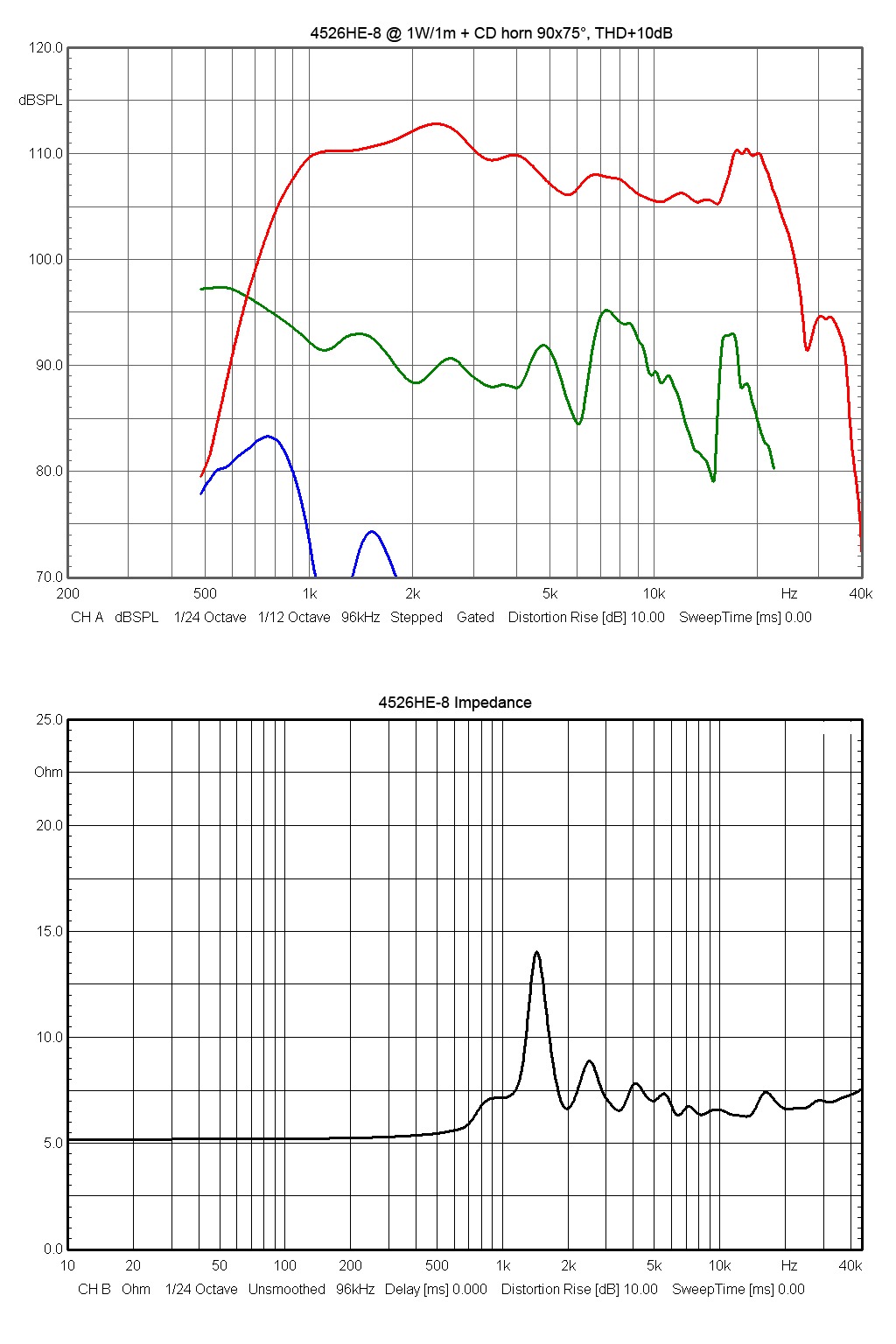
BMS 4526HE. 0.68" throat, 106dB output from 10khz+, 112dB output at 20khz
.
My small horn was for a client that requested the BMS 4526...he made reference to some Patrick guy on the DIYAudio forum. ;-)
I believe his end preference was for the Celestion CDX1-1425 which I also made a horn for. He did a side by side comparison of the two drivers each with their own custom horn. The wood horn that I made for the CDX1 had the throat narrow down to 5/8” diameter before expanding out with the JMLC flare. So it would have near identical polar response between the two horn designs.
My next project is to go down to 1/2” throat using the Wavcor TW013WA01 1/2” dome tweeter mounted to a JMLC horn.
Attachments
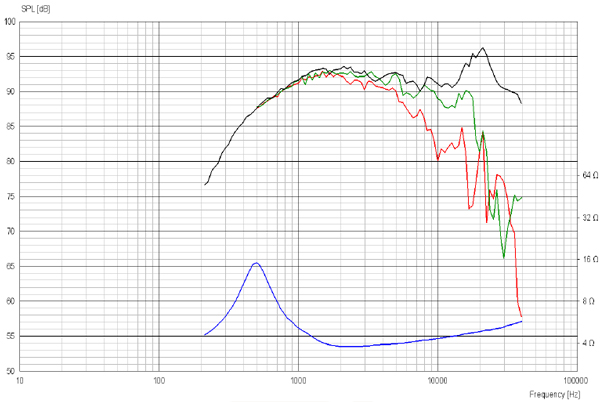
ScanSpeak D2604. 1" soft dome, 91dB output from 10khz+, 96db output at 20khz
That's indeed 96dB at 20kHz but at 15° it got only 90dB at 14kHz and free fall above that!
Basically, if you look at the measurements, there are two devices capable of producing a LOT of high frequency output above 15khz:
1) ribbons
2) very very small compression drivers
3) Air Motion Transformers

For instance, the JBL V20 has *three* dual diaphragm compression drivers, worth about $3000 for the tweeters alone, and it's sensitivity at 20khz is about 98dB! IE, about the same as a $50 ribbon tweeter. Now, obviously, the JBL can take 500 watts and reach SPLs that are completely impossible with a ribbon.
No, that's wrong. It got three compression drivers to keep the distance between the tweeters as low as possible to avoid interferences/comb filter artefacts, as it is in every line array. The tweeters exceed the spl of the 4 synergy-like mid drivers by over 12dB!
Attachments
Air Motion Transformer falls off like a rock @ 20kHz. At least the Beyma TPL-150H does.
It's still much better than the ScanSpeak D2604. 😀 There are others. In general, PA deems spl much more valuable than 20k upper end, most PA speakers (in general) stop at 16-18kHz. That doesn't mean it can't be done though, the Beyma TPL-150 (without the H (horn)) would be a good candidate to add a DIY horn or WG (or use it completely without horn). There are also some Mundorf AMTs which look like a good base for that.
Hi Bill,
Thank for correcting my error - as well as for the Keele paper!
Best regards
Peter
Thank for correcting my error - as well as for the Keele paper!
Best regards
Peter
Peter, according to Keele, it's the other way around -- a larger horn is required to make the dispersion narrower to the same lowest frequency.
https://www.xlrtechs.com/dbkeele.com/PDF/Keele%20(1975-05%20AES%20Preprint)%20-%20Whats%20So%20Sacred%20Exp%20Horns.pdf
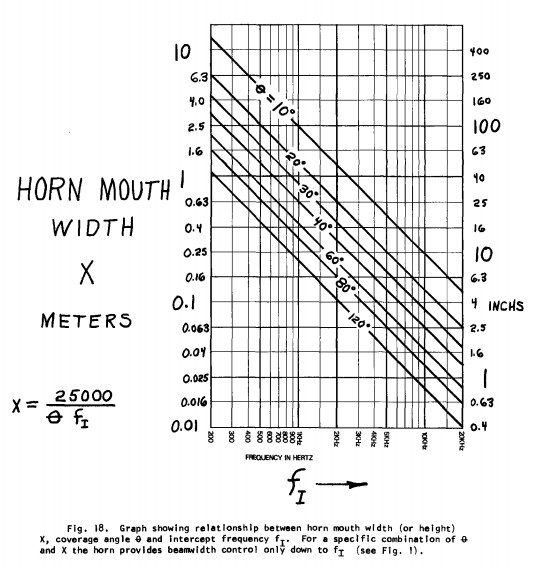
Note that the angle is in the denominator, x (the width) goes up as the angle narrows.
By my understanding, a constant directivity waveguide has about the same response flatness (assuming large enough waveguide for lower part of frequency range) as the compression driver has played into a plane-wave tube. The horns that make the response flatter, lifting the higher frequencies like say an exponential horn does, do so by squeezing the output power at higher frequencies into a smaller projection area.
But correct me if I'm wrong on this.
That's pretty much how I'd put it too.
I'd just add that the total angle of coverage also sets the loading. But let's not forget that the majority of the loading effect comes from the compression ratio.
800Hz tractrix horn waveguide
From a mathematically challanged audiophile-woodworker: Can somebody provide calculations for a 800Hz round Tractrix horn with 1" throat size (TAD 2001)? I plan to cut this horn out of solid hardwood using friend's CNC router. Thanks.
From a mathematically challanged audiophile-woodworker: Can somebody provide calculations for a 800Hz round Tractrix horn with 1" throat size (TAD 2001)? I plan to cut this horn out of solid hardwood using friend's CNC router. Thanks.
You might consider hornresp.exe as this can make the calculations for you. You'll find it as a sticky thread in the subwoofer sub-forum.
Can somebody provide calculations for a 800Hz round Tractrix horn with 1" throat size
Attachments
Hello,
you might also consider my True Expansion Tractrix profile:
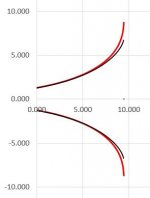
An elliptical stl example file is in the zip attached together with the round coordinates for the normal TET.
A True Expansion Tractrix Horn | Sphericalhorns
you might also consider my True Expansion Tractrix profile:

An elliptical stl example file is in the zip attached together with the round coordinates for the normal TET.
A True Expansion Tractrix Horn | Sphericalhorns
Attachments
Docali, can you calculate 120cm mouth Tractrix? How low it can go? usually Tractrix is space saver.
Hi,
as you see from the chart the TET is no space saver anymore as it respects the correct loading with respect to a spherical wave front which is strictly not perfectly correct. Give me desired cut-off.
as you see from the chart the TET is no space saver anymore as it respects the correct loading with respect to a spherical wave front which is strictly not perfectly correct. Give me desired cut-off.
80 Hz not good for an 1" throat. Then we are in the range of WE snail horns 😀
What should be the throat radius?
What should be the throat radius?
BTW: your opinion about T=0? (flatter horn at throat and longer horn) benefits? We don't have comp driver T/S so hard to tell.
- Home
- Loudspeakers
- Multi-Way
- Horns and waveguides 101
